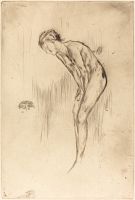Etchings Institutions search term: grolier club
Tillie: A Model | ||
| Number: | 113 | |
| Date: | 1873 | |
| Medium: | drypoint | |
| Size: | 235 x 160 mm | |
| Signed: | butterfly at left | |
| Inscribed: | no | |
| Set/Publication: | no | |
| No. of States: | 5 | |
| Known impressions: | 6 | |
| Catalogues: | K.117; M.116; W.102 | |
| Impressions taken from this plate (6) | ||
TECHNIQUE
Tillie
[m0367], Study of a Nude
[m0368], Study for 'Tillie: A Model'
[m0369] (reproduced above) and Tillie: Study in Pink and Mauve
[m0370] are possibly studies for the drypoint or the oils, The White Symphony: Three Girls
[y087] and The Three Girls
[y088]. One impression of the drypoint ( ) was worked over extensively in wash by the artist, showing that in drypoint, as in oil and pastel, Whistler went to great pains to get the figure just as he wanted it.
) was worked over extensively in wash by the artist, showing that in drypoint, as in oil and pastel, Whistler went to great pains to get the figure just as he wanted it.
 ) was worked over extensively in wash by the artist, showing that in drypoint, as in oil and pastel, Whistler went to great pains to get the figure just as he wanted it.
) was worked over extensively in wash by the artist, showing that in drypoint, as in oil and pastel, Whistler went to great pains to get the figure just as he wanted it.PRINTING
It is fairly rare. Whistler only printed one or two impressions of each state. The first state was printed in black ink on 'antique' (pre-1800) laid paper, with a faint countermark, possibly 'D' ( ), and the second on similar paper (.
), and the second on similar paper (.  ). The third state is on ivory laid paper with a posthorn watermark (
). The third state is on ivory laid paper with a posthorn watermark ( ). The fourth was printed in dark brown ink on ivory laid paper (
). The fourth was printed in dark brown ink on ivory laid paper ( ). The drypoint was still printing with patches of strong burr at this stage.
). The drypoint was still printing with patches of strong burr at this stage.
The sole known impression of the final state was printed in warm black ink, and was worked over extensively in wash. It is on a sheet removed from a book, watermarked 'B/TH' in a decorative circle, with old pen inscriptions on the verso ( ). The sole known cancelled impression - which is probably of the same fifth state - was also printed in black, but this time on cream wove paper, possibly with the intention of publishing it with a set of cancelled etchings in 1879, but it was not included in the album as published (
). The sole known cancelled impression - which is probably of the same fifth state - was also printed in black, but this time on cream wove paper, possibly with the intention of publishing it with a set of cancelled etchings in 1879, but it was not included in the album as published ( ).
).
 ), and the second on similar paper (.
), and the second on similar paper (.  ). The third state is on ivory laid paper with a posthorn watermark (
). The third state is on ivory laid paper with a posthorn watermark ( ). The fourth was printed in dark brown ink on ivory laid paper (
). The fourth was printed in dark brown ink on ivory laid paper ( ). The drypoint was still printing with patches of strong burr at this stage.
). The drypoint was still printing with patches of strong burr at this stage. The sole known impression of the final state was printed in warm black ink, and was worked over extensively in wash. It is on a sheet removed from a book, watermarked 'B/TH' in a decorative circle, with old pen inscriptions on the verso (
 ). The sole known cancelled impression - which is probably of the same fifth state - was also printed in black, but this time on cream wove paper, possibly with the intention of publishing it with a set of cancelled etchings in 1879, but it was not included in the album as published (
). The sole known cancelled impression - which is probably of the same fifth state - was also printed in black, but this time on cream wove paper, possibly with the intention of publishing it with a set of cancelled etchings in 1879, but it was not included in the album as published ( ).
).

